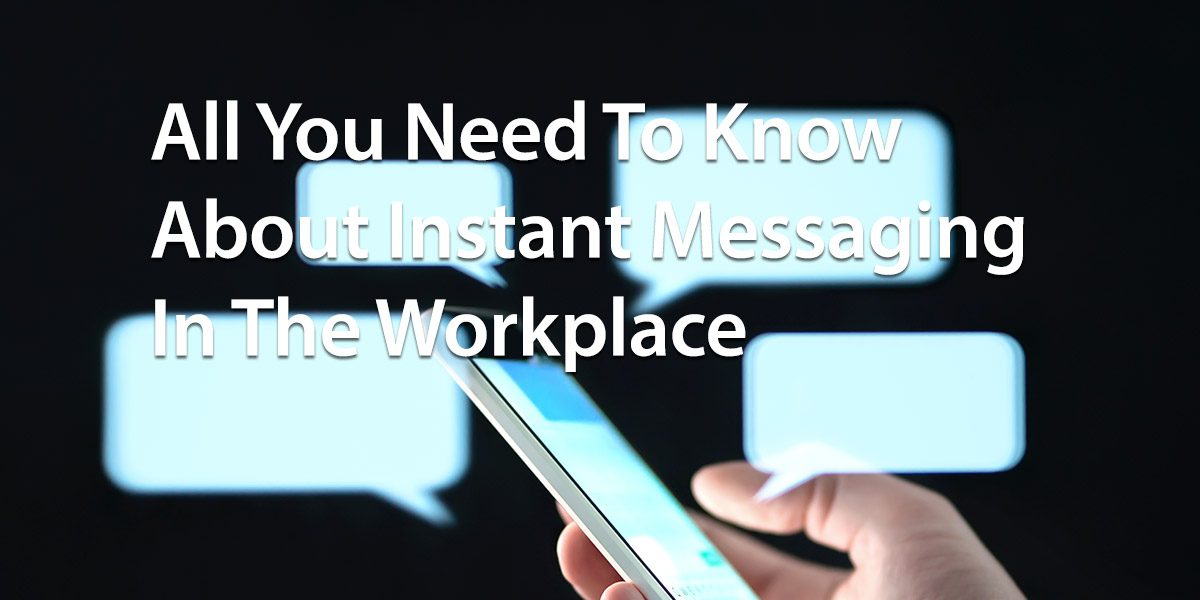There are few things more important in the workplace than effective communication. Instant messaging, which is now used as widely in the corporate world as it is in one’s personal life, is one of the most effective office communication software. Not only have instant messaging platforms proven to be useful adjuncts to traditional modes of communication, but they are also capable of replacing some forms of communication.
The benefit of an instant messaging app for business is that it is almost as fast as phone conversations and has the record-keeping capability of email messaging. While face-to-face interaction and meetings are still beneficial, instant messaging makes communication more convenient and accessible, even if those with whom you need to communicate are across the room or the country.
The immediacy of message exchange distinguishes instant messaging from email. IM is also session-based, with a beginning and an end. Individual messages are frequently brief because IM is intended to mimic in-person conversations. Email, on the other hand, is typically written in a more formal, letter-like style.
How does instant messaging work?
To start a session, instant messaging users must know each other’s username or screen name. It is possible to create contact or buddy lists of frequent contacts. Once the intended recipient has been identified and chosen, the sender launches an IM session.
Users must be online at the same time for IM to work properly, though nearly all instant messaging platforms allow asynchronous interactions between online and offline users. Attempting to IM an unavailable user result in a notification that the transmission cannot be completed if offline messaging is not supported. Furthermore, the intended recipient must be open to receiving instant messages. Most instant messaging tools can reject specific users.
When a message is received, the instant messaging app for business notifies the recipient with a window containing the incoming message, which is often a pop-up window. Alternatively, depending on the user’s preferences, an alert window may appear to indicate that an IM has arrived, along with a prompt to accept or reject it. Many instant messaging tools alert the user with a distinct sound, such as a chime or chirp. When a message arrives, the user can also receive a visual notification, such as the IM window or its taskbar icon flashing.
Why do businesses use instant messaging at work?
Instant messaging is a form of real-time communication between internet users. It is an immediate, convenient, and flexible alternative to email. Instant messaging is faster than email and more direct than other forms of asynchronous communication. Users can IM from a variety of devices other than their phones.
Users can indicate their availability, chat with each other, exchange documents, and hold group meetings using instant messaging systems. Instant messaging is a critical mode of communication for connecting remote workers and coordinating workflows. Applications designed primarily for other purposes are finding their way into IM.
As IM does not require a cellular network, it is a useful alternative to text and Short Message Service (SMS) messages in a consumer context.
Rules to follow while using instant messaging in the workplace
1. Be brief, be quick, and get out!
This adage is commonly used by public speakers, but it also applies to instant messaging. IM is an instant (immediate, fast, prompt, split-second, straightaway, hit-and-run, quick, rapid, speedy, swift) message, as the name implies. It is not intended to replace email and should not be used as such, nor is it intended to be kept over time.
2. Describe yourself
This is the same as meeting in person, over the phone, or via email. If this is your first time sending an IM, please introduce yourself by writing something like, “Hello! I am [name] from [name of department].
3. Respect a person’s time
When you send a message, the recipient might not even be present at his or her desk. Start by asking, “Do you have a minute? “I’d like to ask you a quick question.” Respect the response, whatever it is. When you do not receive an immediate response, you will know the person is unavailable.
4. Be on the same page as your coworkers
Learn how to use all of the features that your instant messaging tool has to offer. Hold mini-training sessions in your office and distribute a brief guideline sheet on how to use IM most effectively. This way, everyone will know what to expect and how to use the tool to its full potential.
5. Do not rush in
Do not send an IM if you see a “do not disturb” or “Away” alert. It is like breaking into someone’s office when the door is closed. Put it off until later. If you are worried about forgetting what you meant to say, keep a notepad next to your computer at all times to jot down reminders for future messages. Also, do not leave your “do not disturb” alert turned on all the time.
6. Limit yourself to one short topic
IM is designed for quick and cordial communication among participants. It is not meant for idle chit-chat or long, drawn-out conversations. Make your messages purposeful and only cover one topic at a time. Use email instead if you have multiple subjects and questions.
7. Use full, grammatically correct sentences
This is not a personal SMS text message. Use capital and lowercase letters correctly. Never use all capital or lowercase letters. It appears that you are sluggish, shouting, or being too casual. Examine the text for misspelt words, poor grammar, and abbreviations or acronyms. Remove all emoticons.
8. Be cautious when it comes to the distribution
Before sending, review the distribution list to ensure that everyone is or is not intended to see the IM. Remember that all content on company systems is the property of the company and can be monitored at any time without your permission. Never send anything that you would be embarrassed to share with the rest of the world.
9. Indicate how quickly you require a response
Waiting one or even two days for an email response is reasonable. The key to effective instant messaging is to be as responsive as possible. Unless your intended recipient has a “busy” alert set, you should expect to hear back within a few minutes, if not within 15-20 minutes. In IM time, 30 minutes is considered long. Always specify how quickly you require a response. If you receive a message and are unable to respond immediately, notify the sender.
10. When and how to end
Unless one person ends with a thank-you or goodbye, it is not always clear when an IM conversation is over. It may not be necessary to go beyond a simple “Thank you.” once you have received a response.
Clariti for Workplace Messaging
There are numerous communication, collaboration, and cloud storage tools available, but each addresses a specific need rather than a broader one. Clariti, on the other hand, combines all of these functions in one app. Clariti is a web app that organizes emails, chats, phone calls, to-do lists, documents, and other data into Conversations. Team members can chat with one another, send and receive emails, schedule events, collaborate on to-do lists, and much more in a single centralized hub. What distinguishes Clariti is that all of the team members’ collaboration takes place in a space dedicated solely to the topic at hand. Finally, your organization will save time and money by training its members with a single tool rather than several.
Clariti uses a “content-rich subject chat” feature. These subject chats make your conversation easy to understand.
Clariti is entirely browser-based, so no downloads are required. You can now sign up for Clariti’s website for free to see if it is a good fit for your company.



































